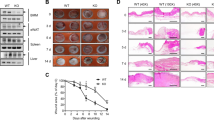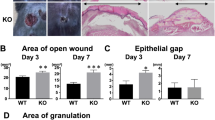Abstract
The inflammatory response is essential for normal cutaneous wound healing. Macrophages, as critical inflammatory cells, coordinate inflammation and angiogenesis phases during wound healing. It has been reported that the transcription factor interferon regulatory factor 8 (IRF8), a member of the IRF family, plays a critical role in the development and function of macrophages and is associated with inflammation. However, the role of IRF8 in cutaneous wound healing and its underlying mechanism remain elusive. Through immunohistochemical (IHC) staining, we showed that IRF8 is involved in the wound repair process in mice and patients. Furthermore, we ascertain that the repression of IRF8 by small interfering RNA (siRNA) leads to delayed wound healing. To explore the mechanism by which IRF8 impacts wound healing, we observed its effect on macrophage-related mediators by IHC or real-time PCR. The results demonstrated that the inhibition of IRF8 decreases the mRNA expression of inflammatory mediators associated with M1 macrophage (il-1b, il-6, inos, and tnf-a) but no impact on M2 macrophage-related mediators (arg-1, mrc-1, and il-10) and the number of macrophages in the wounds. Furthermore, the inhibition of IRF8 induced apoptosis in the wounds. In summary, this study demonstrates that the down-regulation of IRF8 in the wound leads to impaired wound healing possibly through the regulation of macrophage function and apoptosis in skin wound.





Similar content being viewed by others
References
Martin, P. 1997. Wound healing—Aiming for perfect skin regeneration. Science 276(5309): 75–81.
Xu, Z., H. Xu, V.A. Ploplis, and F.J. Castellino. 2010. Factor VII deficiency impairs cutaneous wound healing in mice. Molecular Medicine 16(5–6): 167–176.
Morris Jr., M.W., M. Allukian 3rd, B.J. Herdrich, R.C. Caskey, C. Zgheib, J. Xu, W. Dorsett-Martin, M.E. Mitchell, and K.W. Liechty. 2014. Modulation of the inflammatory response by increasing fetal wound size or interleukin-10 overexpression determines wound phenotype and scar formation. Wound Repair and Regeneration 22(3): 406–414.
Koh, T.J., and L.A. DiPietro. 2011. Inflammation and wound healing: The role of the macrophage. Expert Reviews in Molecular Medicine 13: e23.
Mahdavian Delavary, B., W.M. van der Veer, M. van Egmond, F.B. Niessen, and R.H. Beelen. 2011. Macrophages in skin injury and repair. Immunobiology 216(7): 753–762.
Lucas, T., A. Waisman, R. Ranjan, J. Roes, T. Krieg, W. Muller, A. Roers, and S.A. Eming. 2010. Differential roles of macrophages in diverse phases of skin repair. Journal of Immunology 184(7): 3964–3977.
Mirza, R., L.A. DiPietro, and T.J. Koh. 2009. Selective and specific macrophage ablation is detrimental to wound healing in mice. The American Journal of Pathology 175(6): 2454–2462.
Gu, X.Y., S.E. Shen, C.F. Huang, Y.N. Liu, Y.C. Chen, L. Luo, Y. Zeng, and A.P. Wang. 2013. Effect of activated autologous monocytes/macrophages on wound healing in a rodent model of experimental diabetes. Diabetes Research and Clinical Practice 102(1): 53–59.
Zhang, Q.Z., W.R. Su, S.H. Shi, P. Wilder-Smith, A.P. Xiang, A. Wong, A.L. Nguyen, C.W. Kwon, and A.D. Le. 2010. Human gingiva-derived mesenchymal stem cells elicit polarization of M2 macrophages and enhance cutaneous wound healing. Stem Cells 28(10): 1856–1868.
Dror, N., M. Alter-Koltunoff, A. Azriel, N. Amariglio, J. Jacob-Hirsch, S. Zeligson, A. Morgenstern, T. Tamura, H. Hauser, G. Rechavi, K. Ozato, and B.Z. Levi. 2007. Identification of IRF-8 and IRF-1 target genes in activated macrophages. Molecular Immunology 44(4): 338–346.
Tamura, T., P. Thotakura, T.S. Tanaka, M.S. Ko, and K. Ozato. 2005. Identification of target genes and a unique cis element regulated by IRF-8 in developing macrophages. Blood 106(6): 1938–1947.
Langlais, D., L.B. Barreiro, and P. Gros. 2016. The macrophage IRF8/IRF1 regulome is required for protection against infections and is associated with chronic inflammation. The Journal of Experimental Medicine 213(4): 585–603.
Mancino, A., A. Termanini, I. Barozzi, S. Ghisletti, R. Ostuni, E. Prosperini, K. Ozato, and G. Natoli. 2015. A dual cis-regulatory code links IRF8 to constitutive and inducible gene expression in macrophages. Genes & Development 29(4): 394–408.
Tsujimura, H., T. Nagamura-Inoue, T. Tamura, and K. Ozato. 2002. IFN consensus sequence binding protein/IFN regulatory factor-8 guides bone marrow progenitor cells toward the macrophage lineage. Journal of Immunology 169(3): 1261–1269.
Paschall, A.V., R. Zhang, C.F. Qi, K. Bardhan, L. Peng, G. Lu, J. Yang, M. Merad, T. McGaha, G. Zhou, A. Mellor, S.I. Abrams, H.C. Morse 3rd, K. Ozato, H. Xiong, and K. Liu. 2015. IFN regulatory factor 8 represses GM-CSF expression in T cells to affect myeloid cell lineage differentiation. Journal of Immunology 194(5): 2369–2379.
Wang, H., and H.C. Morse 3rd. 2009. IRF8 regulates myeloid and B lymphoid lineage diversification. Immunologic Research 43(1–3): 109–117.
Kurotaki, D., M. Yamamoto, A. Nishiyama, K. Uno, T. Ban, M. Ichino, H. Sasaki, S. Matsunaga, M. Yoshinari, A. Ryo, M. Nakazawa, K. Ozato, and T. Tamura. 2014. IRF8 inhibits C/EBPalpha activity to restrain mononuclear phagocyte progenitors from differentiating into neutrophils. Nature Communications 5: 4978.
Sasaki, H., D. Kurotaki, N. Osato, H. Sato, I. Sasaki, S. Koizumi, H. Wang, C. Kaneda, A. Nishiyama, T. Kaisho, H. Aburatani, H.C. Morse 3rd, K. Ozato, and T. Tamura. 2015. Transcription factor IRF8 plays a critical role in the development of murine basophils and mast cells. Blood 125(2): 358–369.
Watanabe, T., C. Hotta, S. Koizumi, K. Miyashita, J. Nakabayashi, D. Kurotaki, G.R. Sato, M. Yamamoto, M. Nakazawa, H. Fujita, R. Sakai, S. Fujisawa, A. Nishiyama, Z. Ikezawa, M. Aihara, Y. Ishigatsubo, and T. Tamura. 2013. The transcription factor IRF8 counteracts BCR-ABL to rescue dendritic cell development in chronic myelogenous leukemia. Cancer Research 73(22): 6642–6653.
Szelag, M., Piaszyk-Borychowska, A., Plens-Galaska, M., Wesoly, J., and Bluyssen, H.A. 2016. Targeted inhibition of STATs and IRFs as a potential treatment strategy in cardiovascular disease. Oncotarget. doi:10.18632/oncotarget.9195.
Chmielewski, S., A. Piaszyk-Borychowska, J. Wesoly, and H.A. Bluyssen. 2015. STAT1 and IRF8 in vascular inflammation and cardiovascular disease: Diagnostic and therapeutic potential. International Reviews of Immunology 25: 1–21.
Yan, M., H. Wang, J. Sun, W. Liao, P. Li, Y. Zhu, C. Xu, J. Joo, Y. Sun, S. Abbasi, A. Kovalchuk, N. Lv, W.J. Leonard, and H.C. Morse. 2016. Cutting edge: Expression of IRF8 in gastric epithelial cells confers protective innate immunity against Helicobacter pylori infection. Journal of Immunology 196(5): 1999–2003.
Luda, K.M., T. Joeris, E.K. Persson, A. Rivollier, M. Demiri, K.M. Sitnik, L. Pool, J.B. Holm, F. Melo-Gonzalez, L. Richter, B.N. Lambrecht, K. Kristiansen, M.A. Travis, M. Svensson-Frej, K. Kotarsky, and W.W. Agace. 2016. IRF8 transcription-factor-dependent classical dendritic cells are essential for intestinal T cell homeostasis. Immunity 44(4): 860–874.
Yoshida, Y., R. Yoshimi, H. Yoshii, D. Kim, A. Dey, H. Xiong, J. Munasinghe, I. Yazawa, M.J. O’Donovan, O.A. Maximova, S. Sharma, J. Zhu, H. Wang, H.C. Morse 3rd, and K. Ozato. 2014. The transcription factor IRF8 activates integrin-mediated TGF-beta signaling and promotes neuroinflammation. Immunity 40(2): 187–198.
Xiang, M., L. Wang, S. Guo, Y.Y. Lu, H. Lei, D.S. Jiang, Y. Zhang, Y. Liu, Y. Zhou, X.D. Zhang, and H. Li. 2014. Interferon regulatory factor 8 protects against cerebral ischaemic-reperfusion injury. Journal of Neurochemistry 129(6): 988–1001.
Tamura, T., T. Nagamura-Inoue, Z. Shmeltzer, T. Kuwata, and K. Ozato. 2000. ICSBP directs bipotential myeloid progenitor cells to differentiate into mature macrophages. Immunity 13(2): 155–165.
Koschwanez, H., M. Vurnek, J. Weinman, J. Tarlton, C. Whiting, S. Amirapu, S. Colgan, D. Long, P. Jarrett, and E. Broadbent. 2015. Stress-related changes to immune cells in the skin prior to wounding may impair subsequent healing. Brain, Behavior, and Immunity 50: 47–51.
Collin, M., and P. Milne. 2016. Langerhans cell origin and regulation. Current Opinion in Hematology 23(1): 28–35.
Masuda, T., S. Iwamoto, S. Mikuriya, H. Tozaki-Saitoh, T. Tamura, M. Tsuda, and K. Inoue. 2015. Transcription factor IRF1 is responsible for IRF8-mediated IL-1beta expression in reactive microglia. Journal of Pharmacological Sciences 128(4): 216–220.
Simon, P.S., S.K. Sharman, C. Lu, D. Yang, A.V. Paschall, S.S. Tulachan, and K. Liu. 2015. The NF-kappaB p65 and p50 homodimer cooperate with IRF8 to activate iNOS transcription. BMC Cancer 15: 770.
Yang, D., M. Thangaraju, D.D. Browning, Z. Dong, B. Korchin, D.C. Lev, V. Ganapathy, and K. Liu. 2007. IFN regulatory factor 8 mediates apoptosis in nonhemopoietic tumor cells via regulation of Fas expression. Journal of Immunology 179(7): 4775–4782.
Hu, X., D. Yang, M. Zimmerman, F. Liu, J. Yang, S. Kannan, A. Burchert, Z. Szulc, A. Bielawska, K. Ozato, K. Bhalla, and K. Liu. 2011. IRF8 regulates acid ceramidase expression to mediate apoptosis and suppresses myelogeneous leukemia. Cancer Research 71(8): 2882–2891.
Acknowledgments
This work was supported partially by the National Natural Science Foundation of China (Nos. 81272113 and 81201469).
Author information
Authors and Affiliations
Corresponding author
Ethics declarations
Compliance with Ethical Standards
This study was approved by the Ethics Committee of the Shanghai Ninth People’s Hospital, Shanghai Jiaotong University School of Medicine (2013-022). Preoperative informed consent was obtained from each patient registered in this study in accordance with the institutional guidelines.
Conflict of Interest
The authors declare that they have no conflicts of interest.
Rights and permissions
About this article
Cite this article
Guo, Y., Yang, Z., Wu, S. et al. Inhibition of IRF8 Negatively Regulates Macrophage Function and Impairs Cutaneous Wound Healing. Inflammation 40, 68–78 (2017). https://doi.org/10.1007/s10753-016-0454-8
Published:
Issue Date:
DOI: https://doi.org/10.1007/s10753-016-0454-8




